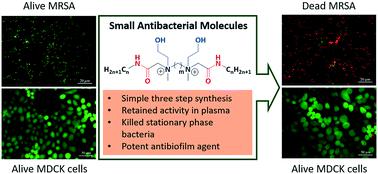当前位置:
X-MOL 学术
›
RSC Med. Chem.
›
论文详情
Our official English website, www.x-mol.net, welcomes your feedback! (Note: you will need to create a separate account there.)
Small antibacterial molecules highly active against drug-resistant Staphylococcus aureus.
RSC Medicinal Chemistry ( IF 4.1 ) Pub Date : 2019-07-30 , DOI: 10.1039/c9md00329k Rajib Dey 1 , Kathakali De 1 , Riya Mukherjee 1 , Sreyan Ghosh 1 , Jayanta Haldar 1, 2
RSC Medicinal Chemistry ( IF 4.1 ) Pub Date : 2019-07-30 , DOI: 10.1039/c9md00329k Rajib Dey 1 , Kathakali De 1 , Riya Mukherjee 1 , Sreyan Ghosh 1 , Jayanta Haldar 1, 2
Affiliation

|
The rapid growth of antibiotic resistance in Staphylococcus aureus coupled with their biofilm forming ability has made the infections difficult to treat with conventional antibiotics. This has created a massive threat towards public health and is a huge concern worldwide. Aiming to address this challenging issue, herein we report a new class of small antibacterial molecules (SAMs) with high antibacterial activity against multidrug-resistant S. aureus. The design principle of the molecules was based on the variation of hydrophobic/hydrophilic balance through incorporation of two quaternary ammonium groups, ethanol moieties, non-peptidic amide bonds and aliphatic chains. The lead compound, identified through a comprehensive analysis of structure–activity relationships, displayed high activity against clinical isolates of methicillin-resistant S. aureus (MRSA) and vancomycin-resistant S. aureus (VRSA) with MIC values in the range of 1–4 μg mL−1. More importantly, this compound was capable of killing stationary phase bacteria and disrupting established biofilms of MRSA. Additionally, the compound revealed minimum toxicity towards human erythrocytes (HC50 = 577 μg mL−1) and did not show significant toxicity towards mammalian cells (MDCK and A549) up to 128 μg mL−1. Remarkably, the incorporation of non-peptidic amide bonds made the compounds less susceptible to degradation in human plasma, serum and mouse liver homogenate. Taken together, the results therefore indicate great promise for this class of molecules to be developed as potent antibacterial agents in treating infections caused by drug-resistant S. aureus.
中文翻译:

小抗菌分子对耐药金黄色葡萄球菌具有高度活性。
金黄色葡萄球菌的抗生素耐药性迅速增长,加上其生物膜形成能力,使得传统抗生素难以治疗感染。这对公共健康造成了巨大威胁,并引起全世界的巨大关注。为了解决这一具有挑战性的问题,我们在此报告了一类新型抗菌小分子(SAM),对多重耐药金黄色葡萄球菌具有高抗菌活性。该分子的设计原理是基于通过引入两个季铵基团、乙醇部分、非肽酰胺键和脂肪链来改变疏水/亲水平衡。通过结构-活性关系的综合分析鉴定出的先导化合物对耐甲氧西林金黄色葡萄球菌(MRSA) 和耐万古霉素金黄色葡萄球菌(VRSA) 的临床分离株表现出高活性,MIC 值范围为 1- 4μg·mL -1。更重要的是,这种化合物能够杀死静止期细菌并破坏已建立的 MRSA 生物膜。此外,该化合物对人类红细胞的毒性最小(HC 50 = 577 μg mL -1),并且对哺乳动物细胞(MDCK 和 A549)没有表现出高达 128 μg mL -1的显着毒性。值得注意的是,非肽酰胺键的掺入使化合物在人血浆、血清和小鼠肝匀浆中不易降解。总而言之,这些结果表明此类分子有很大希望被开发为治疗由耐药金黄色葡萄球菌引起的感染的有效抗菌剂。
更新日期:2019-07-30
中文翻译:

小抗菌分子对耐药金黄色葡萄球菌具有高度活性。
金黄色葡萄球菌的抗生素耐药性迅速增长,加上其生物膜形成能力,使得传统抗生素难以治疗感染。这对公共健康造成了巨大威胁,并引起全世界的巨大关注。为了解决这一具有挑战性的问题,我们在此报告了一类新型抗菌小分子(SAM),对多重耐药金黄色葡萄球菌具有高抗菌活性。该分子的设计原理是基于通过引入两个季铵基团、乙醇部分、非肽酰胺键和脂肪链来改变疏水/亲水平衡。通过结构-活性关系的综合分析鉴定出的先导化合物对耐甲氧西林金黄色葡萄球菌(MRSA) 和耐万古霉素金黄色葡萄球菌(VRSA) 的临床分离株表现出高活性,MIC 值范围为 1- 4μg·mL -1。更重要的是,这种化合物能够杀死静止期细菌并破坏已建立的 MRSA 生物膜。此外,该化合物对人类红细胞的毒性最小(HC 50 = 577 μg mL -1),并且对哺乳动物细胞(MDCK 和 A549)没有表现出高达 128 μg mL -1的显着毒性。值得注意的是,非肽酰胺键的掺入使化合物在人血浆、血清和小鼠肝匀浆中不易降解。总而言之,这些结果表明此类分子有很大希望被开发为治疗由耐药金黄色葡萄球菌引起的感染的有效抗菌剂。


























 京公网安备 11010802027423号
京公网安备 11010802027423号